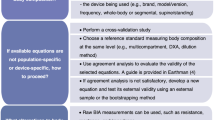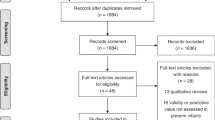Abstract
Background/Objectives
During pregnancy, body composition alterations can be considered as markers of complications and in this context, a non-invasive and low-cost method such as Bioelectrical Impedance Vector Analysis (BIVA), can be employed to monitor such changes. This study aimed at identifying body compartments trend during physiological pregnancy.
Subjects/Methods
Classic and specific BIVA variables have been measured in a sample of 37 pregnant women approximately every 4 weeks of gestation and once postpartum. Researchers used both longitudinal and cross-sectional approach. The first case included data of women from the 11th to the 15th week along with data from the 28th to the 32nd week of gestation. The cross-sectional approach regarded two more specific moments (11th–12th weeks and 30th–31st weeks) and data within two months postpartum
Results
The longitudinal approach showed a significant decrease in classic BIVA variables (R/H, Xc/H, Z/H p < 0.001) and a shortening of the vector, pointing out that TBW and hydration increased significantly. Specific vector length increased significantly, indicating a physiological gain of FM% (p < 0.01). The cross-sectional approach showed lower values of R/H, Xc/H, Z/H between 12th–13th and 30th–31st weeks (p < 0.01), while in the postpartum period values tended to those registered at the beginning of pregnancy. No changes have been found for the phase angle in both approaches, indicating that ECW/ICW ratio remained constant
Conclusions
Among physiological pregnancies, bioelectric values showed a coherent trend and these results represent a first contribution to support routine exams, leading to an early detection of anomalous values potentially correlated to pathologies.
This is a preview of subscription content, access via your institution
Access options
Subscribe to this journal
Receive 12 print issues and online access
$259.00 per year
only $21.58 per issue
Buy this article
- Purchase on Springer Link
- Instant access to full article PDF
Prices may be subject to local taxes which are calculated during checkout


Similar content being viewed by others
References
Sistema Nazionale Linee Guida. Linea guida 2011 – Gravidanza fisiologica. Linee Guida ISS. 2011. https://www.salute.gov.it/imgs/C_17_pubblicazioni_1436_allegato.pdf.
Ghiotti P. Nascere in Piemonte: percorso nascita regionale. 2006–2016. https://www.epi.piemonte.it/pubblicazioni/atlanti/nascere_in_piemonte_2006_2016.pdf.
Benedetto C, Marozio L, Lanzo G. Patologia della gravidanza - Ipertensione in gravidanza. In: Benedetto C, Sismondi P, editors. Ginecologia e Ostetricia. Torino: Minerva Me. 2013. p. 340–54.
Piemonte R. Profilo assistenziale condiviso per l’assistenza diagnostica e terapeutica del diabete gestazionale in dietoterapia. 2015. https://www.regione.piemonte.it/web/sites/default/files/media/documenti/2018-11/3_diabete_gestazionale.pdf.
Wierdis T, Romanini C, Alba E, Arduini D, D’Addato F, Grio R, et al. Ginecologia e Ostetricia (II). Torino: Minerva Medica; 2003.
Institute of Medicine and National Research Council. Weight Gain During Pregnancy: Reexamining the Guidelines. Washington, DC: The National Academies Press. 2009. https://doi.org/10.17226/12584.
Most J, Marlatt KL, Altazan AD, Redman LM. Advances in assessing body composition during pregnancy. Eur J Clin Nutr. 2018;72:645–56.
Lukaski HC, Vega Diaz N, Talluri A, Nescolarde L. Classification of hydration in clinical conditions: indirect and direct approaches using bioimpedance. Nutrients. 2019;11:809. https://doi.org/10.3390/nu11040809.
Bioelectrical impedance analysis in body composition measurement: National Institutes of Health Technology Assessment Conference. Am J Clin Nutr. 1996;64:524S–32S.
Piuri G, Ferrazzi E, Bulfoni C, Mastricci L, Di Martino D, Speciani AF. Longitudinal changes and correlations of bioimpedance and anthropometric measurements in pregnancy: Simple possible bed-side tools to assess pregnancy evolution. J Matern Neonatal Med. 2017;30:2824–30.
Berlit S, Stojakowits M, Tuschy B, Weiss C, Leweling H, Sütterlin M, et al. Bioelectrical impedance analysis in the assessment of pre-eclampsia. Arch Gynecol Obstet. 2015;291:31–8.
Levario-Carrillo M, Avitia M, Tufiño-Olivares E, Trevizo E, Corral-Terrazas M, Reza-López S. Body composition of patients with hypertensive complications during pregnancy. Hypertens Pregnancy. 2006;25:259–69.
Da Silva EG, De Barros Leite Carvalhaes MA, Hirakawa HS, Da Silva EG, Peraçoli JC. Bioimpedance in pregnant women with preeclampsia. Hypertens Pregnancy. 2010;29:357–65.
Berlit S, Tuschy B, Stojakowits M, Weiss C, Leweling H, Sütterlin M, et al. Bioelectrical impedance analysis in pregnancy: Reference ranges. Vivo. 2013;27:851–4.
Valensise H, Andreoli A, Lello S, Magnani F, Romanini C, De Lorenzo A. Multifrequency bioelectrical impedance analysis in women with a normal and hypertensive pregnancy. Am J Clin Nutr. 2000;72:780–3.
Ghezzi F, Franchi M, Balestreri D, Lischetti B, Mele MC, Alberico S, et al. Bioelectrical impedance analysis during pregnancy and neonatal birth weight. Eur J Obstet Gynecol Reprod Biol. 2001;98:171–6.
Larciprete G, Valensise H, Vasapollo B, Altomare F, Sorge R, Casalino B, et al. Body composition during normal pregnancy: Reference ranges. Acta Diabetol. 2003;40:225–32.
Yasuda R, Takeuchi K, Funakoshi T, Maruo T. Bioelectrical impedance analysis in the clinical management of preeclamptic women with edema. J Perinat Med. 2003;31:275–80.
Mardones-Santander F, Salazar G, Rosso P, Villarroel L. Maternal body composition near term and birth weight. Obstet Gynecol. 1998;91:873–7.
Sanin Aguirre LH, Reza-López S, Levario-Carrillo M. Relation between maternal body composition and birth weight. Biol Neonate. 2004;86:55–62.
Rodríguez Atristain A, Miranda-alatriste P, Sánchez-hernández O, Rodríguez-arellano M, Sánchez-trampe B. Vectores de impedancia bioeléctrica para analizar la composición corporal de mujeres mexicanas embarazadas Bioelectrical impedance vector analysis for mexican pregnant’ s body. Rev Espec Médico-Quirúrgicas. 2016;21:55–64.
Lukaski HC, Hall CB, Siders WA. Assessment of change in hydration in women during pregnancy and postpartum with bioelectrical impedance vectors. Nutrition. 2007;23:543–50.
Piccoli A, Rossi B, Pillon L, Bucciante G A new method for monitoring body fluid variation by bioimpedance analysis: The RXc graph. Vol. 46, Kidney international. 1994.
Marini E, Campa F, Buffa R, Stagi S, Matias CN, Toselli S, et al. Phase angle and bioelectrical impedance vector analysis in the evaluation of body composition in athletes. Clin Nutr. 2020;39:447–54.
Marini E, Sergi G, Succa V, Saragat B, Sarti S, Coin A, et al. Efficacy of specific bioelectrical impedance vector analysis (BIVA) for assessing body composition in the elderly. J Nutr Health Aging. 2013;17:515–21.
Buffa R, Saragat B, Cabras S, Rinaldi AC, Marini E. Accuracy of specific BIVA for the assessment of body composition in the United States population. PLoS One. 2013;8:1–10.
Massari F, Scicchitano P, Potenza A, Sassara M, Sanasi M, Liccese M, et al. Supraventricular tachycardia, pregnancy, and water: a new insight in lifesaving treatment of rhythm disorders. Ann Noninvasive Electrocardiol 2018;23:1–5.
World Medical Association. World Medical Association declaration of Helsinki: ethical principles for medical research involving human subjects. JAMA. 2013;310:2191–4.
ISO 7250-1:2017. Basic human body measurements for technological design Body measurement definitions and landmarks. https://www.iso.org/standard/65246.html.
Peebles L, Beverley N. Adultdata: the handbook of adult anthropometric and strength measurements. Data for Design Safety by Laura Peebles and Beverley Norris. UK Department of Trade and Industry (URN 98/736); Ergonomics in Design: The Quarterly of Human Factors Applications. UK: SAGE Publications; 1998. vol 7, p. 32–34.
Piccoli A, Pastori G. BIVA Software background. 2002. http://www.renalgate.it/formule_calcolatori/BIVAguide.pdf.
Toselli S, Marini E, Maietta Latessa P, Benedetti L, Campa F. Maturity related differences in body composition assessed by classic and specific bioimpedance vector analysis among male elite youth soccer players. Int J Environ Res Public Health. 2020;17:729
Marini E, Buffa R, Saragat B, Coin A, Toffanello ED, Berton L, et al. The potential of classic and specific bioelectrical impedance vector analysis for the assessment of sarcopenia and sarcopenic obesity. Clin Inter Aging. 2012;7:585–91.
Wells JC, Williams JE, Ward LC, Fewtrell MS. Utility of specific bioelectrical impedance vector analysis for the assessment of body composition in children. Clin Nutr. 2021;40:1147–54.
Acknowledgements
The authors would like to thank the Ambulatory of Obstetrics and Gynaecology’s staff (Hospital “Ospedale Civile E. Agnelli”), Dr. Valeria Succa for data analysis and statistical support, Dr. Annalisa Costantino for the English language support and Dr. Fabiano Merzari for the help and advice for the starting of this research.
Author information
Authors and Affiliations
Contributions
AM contributed to the conceptualisation of the study design, revised the literature, conducted the research, was responsible for data analysis and interpretation and wrote the original article draught. CV contributed to the conceptualisation of the study design, provided resources, helped in the medical interpretation of results and supervised the development of the entire research. AG contributed to the data analysis and curation. SS contributed to the data analysis, curation and helped in data interpretation. EM contributed to the validation of the methodology, helped in data interpretation and reviewed the entire manuscript. MMC: contributed to the conceptualisation of the study design, provided resources, helped in data analysis and interpretation of results, supervised the development of the entire research and reviewed the manuscript from the original draught.
Corresponding author
Ethics declarations
Competing interests
The authors declare no competing interests.
Additional information
Publisher’s note Springer Nature remains neutral with regard to jurisdictional claims in published maps and institutional affiliations.
Supplementary information
Rights and permissions
About this article
Cite this article
Moroni, A., Vardè, C., Giustetto, A. et al. Bioelectrical Impedance Vector Analysis (BIVA) for the monitoring of body composition in pregnancy. Eur J Clin Nutr 76, 604–609 (2022). https://doi.org/10.1038/s41430-021-00990-7
Received:
Revised:
Accepted:
Published:
Issue Date:
DOI: https://doi.org/10.1038/s41430-021-00990-7
This article is cited by
-
The bioelectrical impedance analysis (BIA) international database: aims, scope, and call for data
European Journal of Clinical Nutrition (2023)



